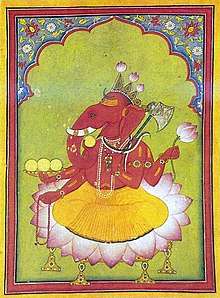Basholi
Basohli (Basoli) formerly Vishwasthali is a town in Kathua district in the union territory of Jammu and Kashmir, India. It is situated on the right bank of River Ravi at an altitude of 1876 ft. It was founded by Raja Bhupat Pal sometime in 1635. It was known for the palaces which are now in ruins and miniatures paintings (Basohli Paintings). The Battle of Basoli was fought in the area.
Basohli Vishwasthali | |
|---|---|
Town | |
| Nickname(s): Basohli | |
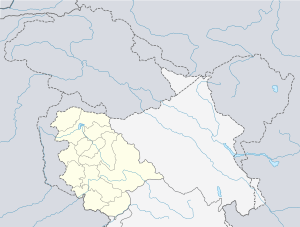 Basohli Location in Jammu and Kashmir, India  Basohli Basohli (India) | |
| Coordinates: 32.50°N 75.82°E | |
| Country | |
| Union Territory | Jammu and Kashmir |
| District | Kathua |
| Elevation | 1,200 m (3,900 ft) |
| Population (2011) | |
| • Total | 5,433 |
| Languages | |
| • Official | Dogri Hindi |
| Time zone | UTC+5:30 (IST) |
Geography
Basholi is located at 32.50°N 75.82°E.[2] It has an average elevation of 460 metres (1509 feet). Basoli is situated in the uneven lofty hills of Shiwaliks. It is situated in the right bank of Ravi river. Basoli's Thein dam has made it almost landlocked. Before the construction of Ranjit Sagar dam or Thein dam Basoli was just 32 km from Kathua but now due the dam it is about 72 km from Kathua city.
Demographics
According to 2011 census India census,[3] Basohli town (urban) had a population of 5433. Males constituted 52.01% of the population and females 47.99%. Bashohli had an average literacy rate of 77%, higher than the national average of 59.5%; with 57% of the males and 43% of females literate. 12% of the population was under 6 years of age.
Religion
Hindu 83.01%, Muslim 16.38%, Other 0.61%[4]
Basholi painting
Basholi is widely known for its paintings called Basholi paintings, which are considered the first school of Pahari paintings, and which evolved into the much prolific Kangra paintings school by mid-eighteenth century.[5] The painter Nainsukh ended his career in Basholi.
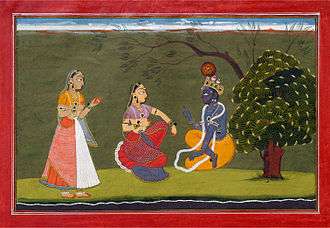
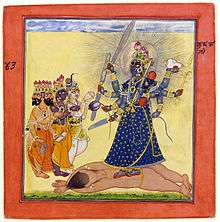 Goddess Bhadrakali, adored by the Gods. Basohli. India. c 1660-70.
Goddess Bhadrakali, adored by the Gods. Basohli. India. c 1660-70.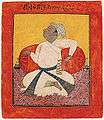
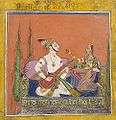 Ragaputra Velavala of Bhairava, opaque watercolour with gold on paper (ca. 1710).
Ragaputra Velavala of Bhairava, opaque watercolour with gold on paper (ca. 1710).
_of_Basohli_LACMA_M.80.223.1.jpg)
Basohli painting was a vigorous, bold and imaginative artistic style, rich, stylish and unconventional. A style of painting characterized by vigorous use of primary colours and a peculiar facial formula prevailed in the seventeenth and early eighteenth centuries in the foothills of the Western Himalayas in the Jammu and Punjab States. The earliest paintings in this style have been dated to the time of Raja Kirpal Pal (1678–93).[6]
Originating in Basohli State, the style spread to the Hill States of Mankot, Nurpur, Kulu, Mandi, Suket, Bilaspur, Nalagarh, Chamba, Guler and Kangra. The first mention of Basohli painting is in the annual report of the Archaeological Survey of India for the year published in 1921. Referring to the acquisitions of the Archaeological Section of the Central Museum, Lahore, the report states that "a series of old paintings of the Basohli School were purchased, and the Curator concludes that the Basohli Schools is possibly of pre-Moghul origin, and so called Tibeti pictures are nothing but late productions of this school".
History
A Battle was fought at Basoli, it was called as the Battle of Basoli between Sikhs and Mughal Empire in 1702.
Places to visit
- Dhar Mahanpur
It is new emerging tourist spot in middle Himalayas. It is 27 km from Basohli (Tehsil HQ) and 87 km from Kathua. It is a ridge blanked with thick chir, deodhar and shrubs. It has a viewing experience is that is excellent. It experiences temperate type of climate that many visitors enjoy. It receives winter rainfall from western disturbances and summer rainfall from monsoons. Cold winter and pleasant summer are the main attractions of this place. Many Tourist Melas are organized by the Tourist Department of J&K Govt to promote tourism in the area. Tourist Huts are also proposed to be constructed. It is served by bus service available from Basohli (tehsil HQ).
- Sanan Ghat
A small town on Basohli-Dhar mahanpurIt is situated at a height of 3700 ft. It is a ridge flanked with thick CHIR, DEODAR and SHRUBS. It experiences temperate type of climate . Cold winter and pleasant summer are the main attractinns of this place.
- Jodeya Mata (Sheetla Mata)
Sheetla Mata Temple is situated approximately 200 km from Jammu. This temple is located in Jodeya, a village of bani Tehsil in kathua district( Jammu Kashmir). This temple is about 50 km from Basohli. Here the weather is always cold, and in winter days, there is a view of the snow. A lot of people are seen in Navratri days. Thousands of pilgrims from far and far come to visit the temple. To visit this temple, about 12 km pedestrian travel has to be done. Mata's temple is in a small field of mountain peak. There is a living and eating arrangement near the temple. Hospice has been built to stay and other facilities for staying are also available there.
- Ranjit Sagar Dam (Thein)
Hydro electric Project (Thein Dam) being constructed at the west bank of river Ravi by the Govt of Punjab and Himachal Paradesh. It as 6 turbines. It is 600 MW Hydel project. The Govt of Punjab, Himachal Paradesh and Jammu and Kashmir are the beneficiaries of this Project. Jammu & Kashmir has 20% share in this project. Prime Minister Sh Atal Behari Bajpayee has inaugurated the project . At present only one turbine is working (producing 150 MW). The Officers Colony is at Shahpur Kandi (Pathankot), 25 km from Kathua.
- Sewa Hydel Project
The 120 MW Sewa-II Hydropower Station is constructed by NHPC Limited on the Sewa river, tributary of Ravi River between Gatti village (Bani Tehsil) and Maska village (Basohli Tehsil) of Kathua District.
SEWA HYDRO-ELECTRIC PROJECT was launched by Minister for Power Mr Surjit Singh Slathia at Mashka in Basohli Tehsil of Kathua District. The Project was commissioned by NHPC in July 2010 and the Power generated by this Project goes into the pool of National Grid of India. The state of J&K gets its due power share from the pool.
- Chamunda Devi
Chamunda Devi Temple is located near the main chowk in Basohli town. The goddess is worshiped here in the shape of Natural rock. It is highly venerated by the people.
- Basohli Bridge
A stunning cable-stayed bridge in Basohli (Jammu & Kashmir). Strategically important and first of the kind in North India and Jammu and Kashmir, the 592-meter long Basohli Bridge over River Ravi will be fourth such in the country. Out of 592 m, 350 m span is cable-stayed while the rest is plain bridge. Built at a cost of Rs 145.44 crore, Basohli Bridge is strategically very important for the quick induction of the Army during emergency. Named Atal Sethu, the bridge will also reduce the distance between Pathankot and Basohli by more than 35 km, saving both time and fuel.
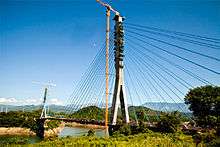
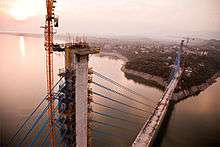
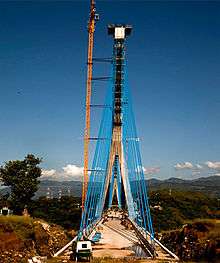
See also
References
- National Museum, New Delhi. For description of the work see: Martin-Dubost (1997), p. 73, which says: "Ganesha getting ready to throw his lotus. Basohli miniature, circa 1730. National Museum, New Delhi. Attired in an orange dhoti, his body is enitirely red. On the three points of his tiny crown, budding lotuses have been fixed. Gaṇeśa holds in his two right hands the rosary and a cup filled with three modakas (a fourth substituted by the curving trunk is just about to be tasted). In his two left hands, Gaṇeśa holds a large lotus above and an axe below, with its handle leaning against his shoulder. In the Mudgalapurāṇa (VII, 70), in order to kill the demon of egotism (Mamāsura) who had attacked him, Gaṇeśa Vighnarāja throws his lotus at him. Unable to bear the fragrance of the divine flower, the demon surrenders to Gaṇeśa."
- Falling Rain Genomics, Inc - Basholi
- "Census of India 2001: Data from the 2001 Census, including cities, villages and towns (Provisional)". Census Commission of India. Archived from the original on 16 June 2004. Retrieved 1 November 2008.
- http://www.census2011.co.in
- Pahari centres Arts of India: Architecture, Sculpture, Painting, Music, Dance and Handicraft, by Krishna Chaitanya. Published by Abhinav Publications, 1987. ISBN 81-7017-209-8. Page 62.
- A Review of Basohli Style in Indian Painting, Chandramani Singh, Kailash - Journal of Himalayan Studies vol 2, Number 1&2, 1974 Archived 6 September 2006 at the Wayback Machine
Further reading
- Hutchinson, J. & J. PH Vogel (1933). History of the Panjab Hill States, Vol. I. 1st edition: Govt. Printing, Pujab, Lahore, 1933. Reprint 2000. Department of Language and Culture, Himachal Pradesh. Chapter XVIII Basohli State, pp. 587–613.
- Kossak, Steven (1997). Indian court painting, 16th-19th century. New York: The Metropolitan Museum of Art. ISBN 0870997831. (see index: p. 148-152, for information about Basholi painting)
